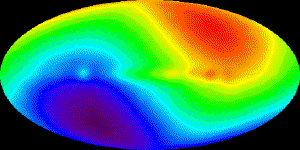Blog
Slow Down,
You Move Too Fast
17 July 2014
 WMAP
WMAPThe cosmic microwave background (CMB) is the faint glow of the primordial fireball known as the big bang. It is often portrayed as existing at the most distant edge of the observable universe, but in fact the entire universe is filled with a sea of photons from the CMB. These photons interact with objects in the universe. In some cases they can interact quite strongly.
When an object moves through space relative to the CMB, this sea of photons is Doppler shifted due to the relative motion. We can see this effect on Earth. The Earth moves relative to the CMB at a speed of about 360 km/s. As a result, the cosmic background in our direction of motion appears slightly hotter, while the direction away from our motion appears slightly cooler.
Normally this effect is too small to worry about, but in the case of cosmic rays it can have a big effect. Cosmic rays are high energy particles, typically protons, that are observed to strike Earth’s atmosphere. Many of these cosmic rays have so much energy that they travel at nearly the speed of light relative to Earth. This means they are also moving at nearly the speed of light relative to the cosmic microwave background. As a result, these particles observe an extremely hot sea of photons in their direction of travel. From the viewpoint of the cosmic particles, it is as if an intense beam of gamma rays is being shined in their direction.
As a result, there is a theoretical upper limit to the amount of energy a cosmic ray can have. It is known as the Greisen–Zatsepin–Kuzmin limit (GZK limit). Basically, as high energy proton speeds through the cosmic sea of photons, some of them collide with the proton, causing it to scatter. Above a certain threshold, the photons collide with the proton with so much energy that particles can be created. At the lowest level they can produce electrons and positrons, but at higher energies they can produce pions. These collisions drain so much energy from the proton that fairly quickly (over the course of millions of light years) the cosmic ray will drop below the GZK limit.
At least that is the theory. We have observed cosmic rays approaching that limit, such as the famous “Oh My God!” particle. Whether it is possible for cosmic rays to have energies above the GZK limit is a matter of some debate.
As an interesting side-point, this effect also stands in the way of any civilization wanting to travel the stars. Even if a ship could be accelerated to near the speed of light, it would still have to deal with a shower of gamma rays from the birth of the universe.